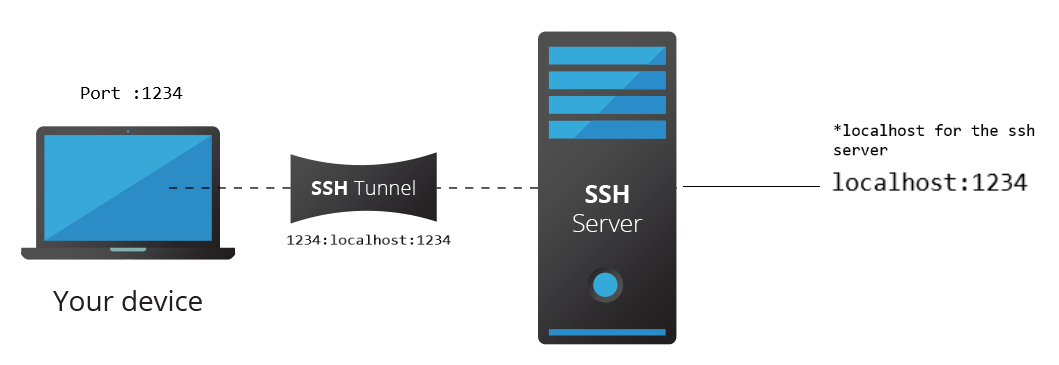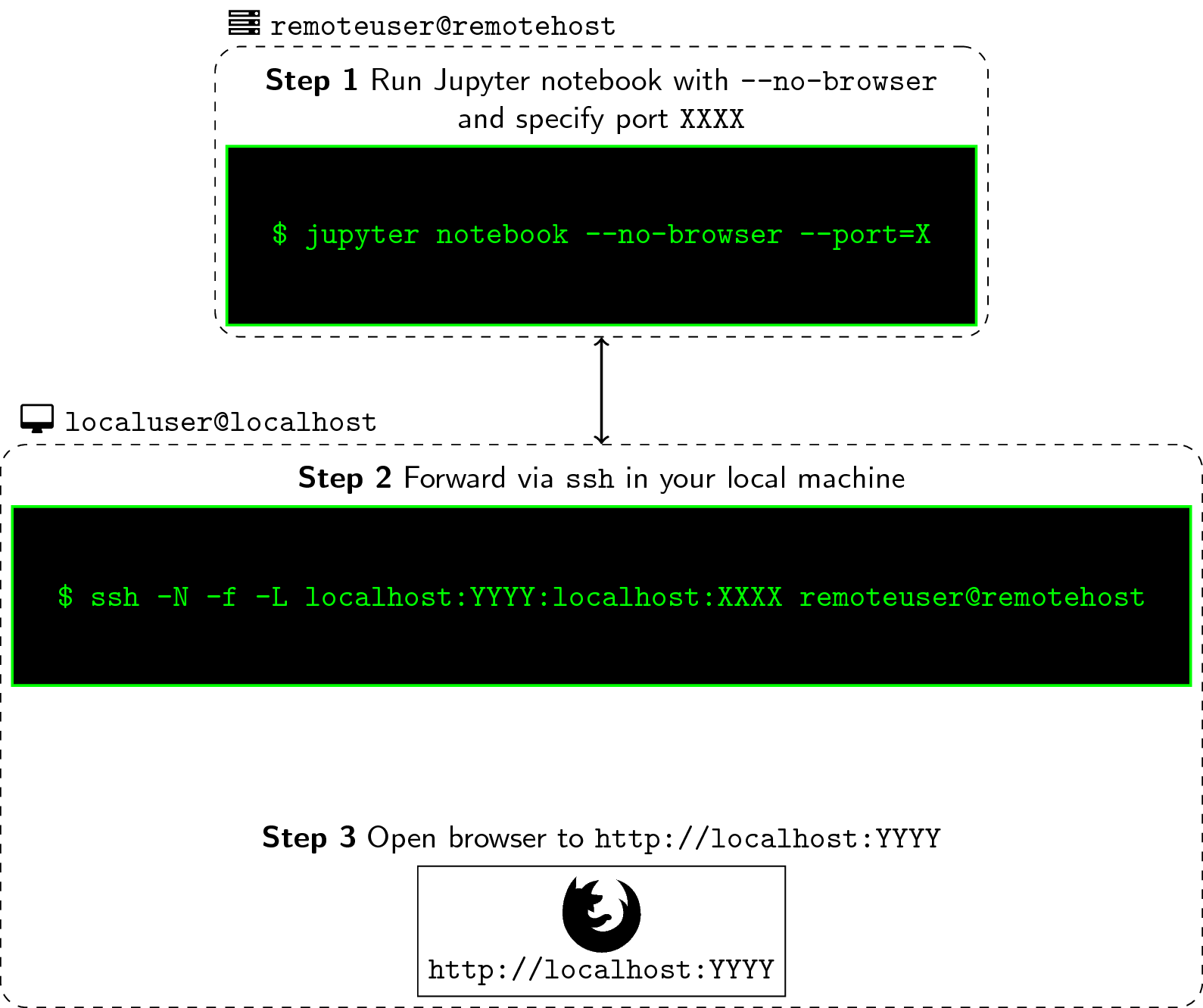Ssh jer remote -machine. Optional On the remote -machine run tmux.

Use Jupyter Notebook Remotely Pytraj 2 0 2 Dev0 Documentation
Jupyter notebook After running this command you will see output similar to the following.

. Localhost8887 you will see your Jupyter notebooks asking for a password token. Ssh -NfL localhost9999localhost9999 your_user_nameremote_ip_address Go to. The firewall must also allow connections from 127001 localhost on ports from 49152 to 65535.
To run Jupyter Notebook with remote kernels first you need a kernel server that exposes an API to manage and communicate with kernels. Ssh into the remote-machine. From now on you can write jupyter notebook on the remote web browser.
Forward port XXXX to YYYY and listen to it. To run the Jupyter Notebook server enter the following command. Once the console shows type the following.
After typing the above command server works well. Session Steps to Run a Remote Jupyter Notebook. RunAccess Jupyter Notebook From Remote Server.
Dont forget to change jer and remote-machine to your user and machine name. Run Jupyter Notebook from remote machine. Being able to run Jupyter Notebooks on remote systems adds tremendously to the versatility of your workflow.
Jupyter notebook --no-browser --port8086. Forward port XXXX to YYYY and listen to it. Running Jupyter Notebooks On Remote Servers By Tobias.
In most cases this is simply done via an ssh command. This is a Jupyter password. The basic syntax is as follows.
What Ill do is mostly OS independent but I am putting an emphasis on Windows 10 since many people are not familiar with tools like ssh on that OS. LocalhostYYYY Again the reason why were opening it at YYYY and not at XXXX is because the latter is already being forwarded to the former. Step 2 Running the Jupyter Notebook.
We will use the Secure Shell Protocol SSH to start the Jupyter Notebook server on the remote server. You will see the Jupyter Notebook running in your browser while the code in the notebook is executed on the remote server. Then copy the token and paste it and login.
Usually the default is 8888. How to run Jupyter Notebooks on remote server SSH Using SSH Tunneling Using Reverse Proxy. If your remote session gets disconnected tmux will keep the session running to reconnected run tmux attach.
Login to Remote Server. Jupyter Notebook must be run from your VPS so that you can connect to it from your local machine using an SSH Tunnel and your favorite web browser. In this post I will show a simple way to do this by taking advantage of some nifty features of secure shell ssh.
It allows clients to provision and communicate with. Back out of your running Jupyter notebook on the remote and run jupyter notebook password. Jupyter notebook --no-browser --port9999 On the local machine catch the forwarded port.
Optional On the remote-machine run tmux. Jupyter notebook --no-browser --portXXXX Note. In your remote the notebook is now running at the port XXXX that you specified.
To open up the Jupyter notebook from your remote machine simply start your browser and type the following in your address bar. Jupyter notebook no-browser ipyour server IP Address port8888. Log-in to your remote machine the usual way you do.
How does a Jupyter notebook work. When youre logged into your remote via ssh you can. You can either if you havent set a password insert the token that should be displayed a bunch of letters and numbers in the remote or if you dont see this youll need to set a password.
Once logged in to the remote server cd to the desired directory and run the following command. To function correctly the firewall on the computer running the jupyter notebook server must be configured to allow connections from client machines on the access port cNotebookAppport set in jupyter_notebook_configpy to allow connections to the web interface. Ssh usernameemail protectedremote_server_ip command.
The Jupyter Kernel Gateway satisifies the first need. Ssh into the remote -machine. On the remote machine start jupyter notebook from your current directory and specify the port.
Change XXXX to the port of your choice. Dont forget to change jer and remote -machine to your user and machine name. If playback doesnt begin shortly try restarting your device.
Steps to Run a Remote Jupyter Notebook. Log-in to your remote machine the usual way you do. Running a Jupyter notebook from a remote server.
Steps to Run Jupyter Notebook Remotely. This will prompt you to write and verify a password which. Just a normal SSH login.
SSH allows us to send commands to the remote server. Replace with your username and server address. In your remote the notebook is now running at the port XXXX that you specified.
And then So Lets run jupyter notebook server. Notebook Starting the Remote Notebook Server. Log-in to your remote machine the usual way you do.
Just type Httpyour server IP Addressport number. Run Jupyter Notebook from remote machine. How To Run An IPythonJupyter Notebook On A Remote.
To run a different TensorFlow 20 image with Jupyter Notebook as an alternative you can also this image with jupyter notebook sudo nvidia-docker run -it -p 80008000. Second you need to modify the default behavior of the Notebook server which is to spawn kernels as local processes on the same host. Run Notebook with Specified Port Number.

How To Run Jupyter Notebooks On Remote Server Ssh By Pranav Gajjewar Medium

Running Jupyter Notebooks On A Remote Server Via Ssh Tech Talk Tone

How To Install Run And Connect To Jupyter Notebook On A Remote Server Digitalocean

How Can Connect Jupyter Notebook In Desired Environment In Anaconda In Server Computer By Using Putty Stack Overflow

How To Install Run And Connect To Jupyter Notebook On A Remote Server Digitalocean

Tips For Running Jupyter Notebook On Remote Server Just Chillin

Running A Jupyter Notebook From A Remote Server

How To Connect To Your Remote Ipython Jupyter Notebook From Your Local Windows Machine By Chris Fotache Medium
0 comments
Post a Comment